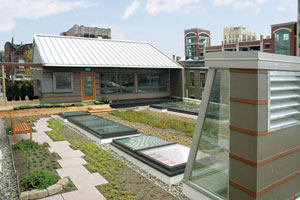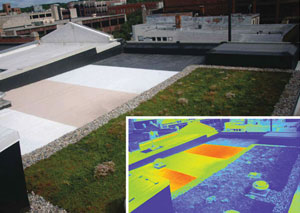Cool Roofs for Hot Projects
What's Next in Cool Roofing
We have seen major breakthroughs in cool roof technology in the past decade. Formula improvements such as light reflective pigments have extended cool roofs to include colored and steep sloped products. The scope of research is not only improving existing product types, but changing the way product samples are rated, and exploring new product types that redefine the roof and its interaction with solar radiation and weathering in a whole new way.
Sustainable Design Research Laboratory, Ann Arbor, MI |
In 2006, A3C Collaborative Architecture decided to convert their offices into a learning lab for numerous environmental systems and products and created the urbEn Retreat, a rooftop meeting space that overlooks a demonstration cool and green roof.
This thermal image illustrates the reflected solar radiation from three different cool roof surfaces on an Ann Arbor, MI rooftop. The two roof segments that appear bright orange correspond to the two most reflective products and the bright yellow segments to the somewhat less reflective product. The dark purple areas indicate the non-cool portions of the roof (or the least reflective surfaces). Photos courtesy of A3C Collaborative Architecture. |
Â
The LBNL Heat Island Group is developing a method to accelerate the aging process for aged testing. Currently both the CRRC Product Rating Program and ENERGY STAR require products to be tested after three years of weathering to gauge the performance of products over their lifespan. Accelerated aging would mimic the weathering process in a span of a few months rather than years, allowing the industry to evolve product formulas as fast as manufacturers can test them. The Heat Island Group is also exploring a self-cleaning surface, which would help products maintain their solar performance over time. This could have significant impact on the required maintenance of a roof, as well as the roof's durability.
While cool roofs have been an easy, passive energy efficiency strategy, new research is redefining the function of a roof. As mentioned above, in the "Solar and Green Roofs" section, manufacturers are investigating how to marry the energy generation benefits of solar systems with the reflective properties of a cool roof. New innovative technology continues to burst on the market, including a recycled cooking oil roof coating that can sense temperature changes and either reflect or absorb solar radiation based on preset temperature thresholds unique to that building and climate and holographic materials that reflect light that shines down from the sky yet look dark colored to those viewing the roof from below.12





 The project covers several thermal studies of cool roof performance in southeast Michigan. While several studies have been done of other areas of the country, none have factored in the lake effect and weather conditions of Lower Michigan, where there tend to be only three days of clear sky during December, January and February. The weather can typically be described as cold, dark, grey and snowy. A3C is working with the University of Michigan Architecture School's Sustainable Design Lab to assess the performance of cool roofs over a full year. While results are not yet fully compiled, the initial returns show that cool roofs provide a benefit to building owners in the region by reducing rooftop thermal gain during the summer.
The project covers several thermal studies of cool roof performance in southeast Michigan. While several studies have been done of other areas of the country, none have factored in the lake effect and weather conditions of Lower Michigan, where there tend to be only three days of clear sky during December, January and February. The weather can typically be described as cold, dark, grey and snowy. A3C is working with the University of Michigan Architecture School's Sustainable Design Lab to assess the performance of cool roofs over a full year. While results are not yet fully compiled, the initial returns show that cool roofs provide a benefit to building owners in the region by reducing rooftop thermal gain during the summer. Measurements from the first day of summer and the hottest day of summer show that the white membrane cool roof provides an 80 percent reduction in heat transfer through the roof as compared to the black EPDM roof, providing a substantial benefit to the building owner. Data for the spring and fall months indicates that there is no heating penalty, or heat loss through the roof, that can be directly attributed to the cool roof. Similarly, when the roof is covered with snow during the winter months, the data indicates that there is a negligible and equal heat loss through the cool and non-cool roof surfaces. Measurements from this study show that cool roofs can not only be effective in cool climates, but are also applicable for both sloped and flat surface configurations.
Measurements from the first day of summer and the hottest day of summer show that the white membrane cool roof provides an 80 percent reduction in heat transfer through the roof as compared to the black EPDM roof, providing a substantial benefit to the building owner. Data for the spring and fall months indicates that there is no heating penalty, or heat loss through the roof, that can be directly attributed to the cool roof. Similarly, when the roof is covered with snow during the winter months, the data indicates that there is a negligible and equal heat loss through the cool and non-cool roof surfaces. Measurements from this study show that cool roofs can not only be effective in cool climates, but are also applicable for both sloped and flat surface configurations.



